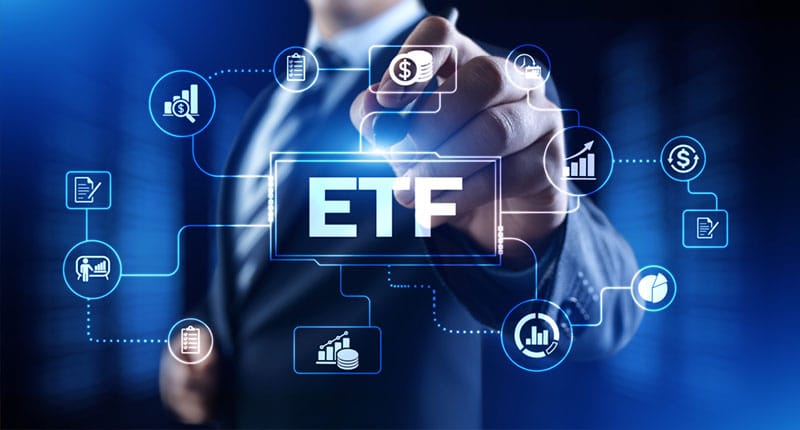If you’re interested in investing, you may have come across the term “ETF.” But what exactly is an ETF, and how can you use it to grow your wealth? In this beginner’s guide to ETF investing, we’ll explore the basics of ETFs, how they work, and why they might be a good choice for your investment portfolio.
What is an ETF?
An ETF, or Exchange Traded Fund, is an investment fund that trades on an exchange like a stock. ETFs are designed to track a specific index, such as the S&P 500 or the NASDAQ. When you invest in an ETF, you’re buying a small piece of a large portfolio of stocks or other assets.
ETF vs Mutual Fund
While ETFs are similar to mutual funds in many ways, there are some key differences. Mutual funds are priced once a day after the markets close, whereas ETFs trade like stocks throughout the trading day. Additionally, ETFs typically have lower fees and more tax-efficient structures than mutual funds.
Types of ETFs
There are many different types of ETFs to choose from, each with its own investment objective. Some ETFs track broad market indexes like the S&P 500, while others focus on specific sectors, such as technology or healthcare. There are also ETFs that invest in bonds, commodities, or international markets.
Advantages of ETFs
One of the main advantages of ETFs is their low fees. Because they track an index rather than being actively managed, ETFs typically have lower expense ratios than mutual funds. Additionally, ETFs offer the flexibility to trade like a stock, which can be appealing to active traders.
Disadvantages of ETFs
While there are many advantages to investing in ETFs, there are also some potential downsides to consider. Because ETFs trade like stocks, they can be subject to price fluctuations and market volatility. Additionally, while ETFs offer diversification benefits, they may not provide the same level of customization as individual stock picking.
How to invest in ETFs
Investing in ETFs is relatively easy and can be done through a brokerage account. Most online brokers offer a range of ETFs to choose from, and you can buy and sell shares just like you would with individual stocks. Some brokers also offer commission-free ETF trading.
ETFs vs Individual Stocks
While ETFs offer a level of diversification that individual stock picking can’t match, there are some benefits to owning individual stocks. For one, owning individual stocks allows you to customize your portfolio to your liking. Additionally, owning individual stocks can provide the potential for higher returns than ETFs, although this comes with higher risk.
Diversification with ETFs
One of the main benefits of investing in ETFs is the diversification they offer. Because ETFs track a specific index or sector, they allow you to invest in a broad range of assets with a single investment. This can help reduce risk and volatility in your portfolio.
Tax implications of ETFs
Because ETFs are structured differently than mutual funds, they often have more favorable tax treatment. For example, ETFs are generally more tax-efficient than mutual funds because they don’t have to sell assets to meet investor redemptions. Additionally, ETF investors only owe taxes when they sell their shares, whereas mutual fund investors may owe taxes on capital gains distributions even if they don’t sell their shares.
Choosing the Right ETFs
When choosing ETFs to invest in, there are a few key factors to consider. First, you’ll want to look at the expense ratio and make sure it’s competitive with other similar ETFs. Additionally, you’ll want to consider the investment objective of the ETF and make sure it aligns with your own investment goals. Finally, you may want to look at the fund’s holdings to make sure they’re diversified and well-suited to your risk tolerance.
ETF Expense Ratios
Expense ratios can have a significant impact on your investment returns, so it’s important to pay attention to them when choosing ETFs. The expense ratio is the annual fee charged by the ETF to cover its operating costs. While expense ratios for ETFs are generally lower than those for mutual funds, they can still vary significantly from one ETF to another.
Understanding ETF Performance
When evaluating the performance of an ETF, it’s important to look beyond just the raw returns. You’ll also want to consider factors like volatility, diversification, and risk-adjusted returns. Additionally, you’ll want to look at the underlying index the ETF tracks and how it has performed over time.
Rebalancing Your ETF Portfolio
As with any investment portfolio, it’s important to periodically rebalance your ETF holdings. This means selling some shares of ETFs that have done well and using the proceeds to buy more shares of ETFs that haven’t performed as well. Rebalancing helps ensure that your portfolio stays aligned with your investment goals and risk tolerance.
ETF Investment Strategies
There are many different strategies you can use when investing in ETFs, depending on your goals and risk tolerance. Some investors prefer to use a “core and satellite” approach, where they invest in a broad-based ETF for their core holdings and then add satellite holdings in specific sectors or asset classes. Others may prefer a more active approach, using ETFs to trade in and out of different sectors or asset classes based on market conditions.
Conclusion
Investing in ETFs can be a smart way to grow your wealth while minimizing risk. By tracking a specific index or sector, ETFs offer broad diversification benefits with low fees and tax-efficient structures. As with any investment, it’s important to do your research and choose ETFs that align with your investment goals and risk tolerance.
FAQs
- Can ETFs be traded like stocks? Yes, ETFs can be bought and sold like individual stocks throughout the trading day.
- What is an ETF’s expense ratio? An ETF’s expense ratio is the annual fee charged by the fund to cover its operating costs.
- Are ETFs more tax-efficient than mutual funds? Yes, ETFs are generally more tax-efficient than mutual funds because they don’t have to sell assets to meet investor redemptions.
- What factors should I consider when choosing ETFs to invest in? You’ll want to look at factors like the expense ratio, investment objective, and fund holdings when choosing ETFs to invest in.
- How often should I rebalance my ETF portfolio? You should aim to rebalance your ETF holdings at least once a year, although some investors may prefer to do so more frequently.










